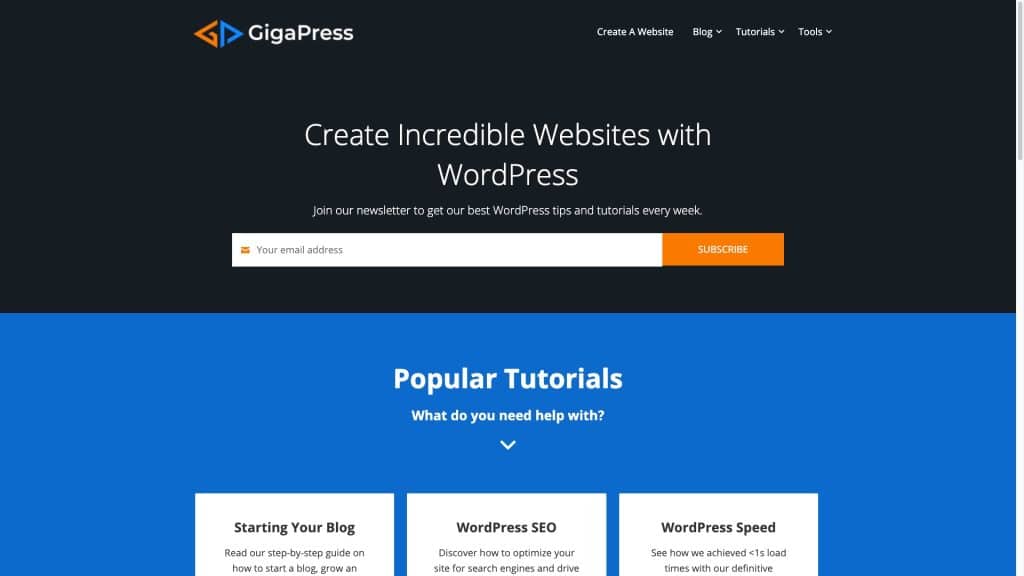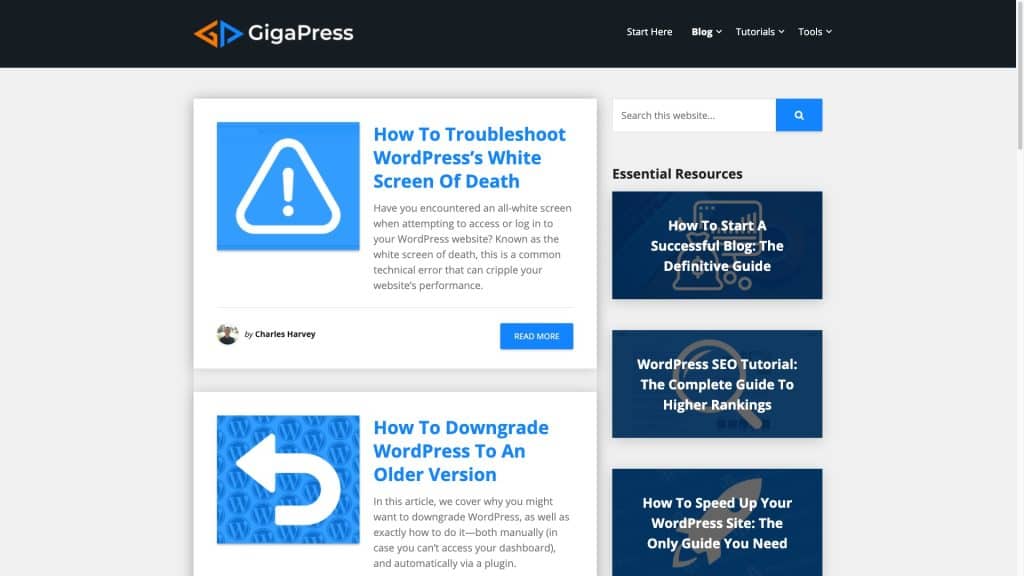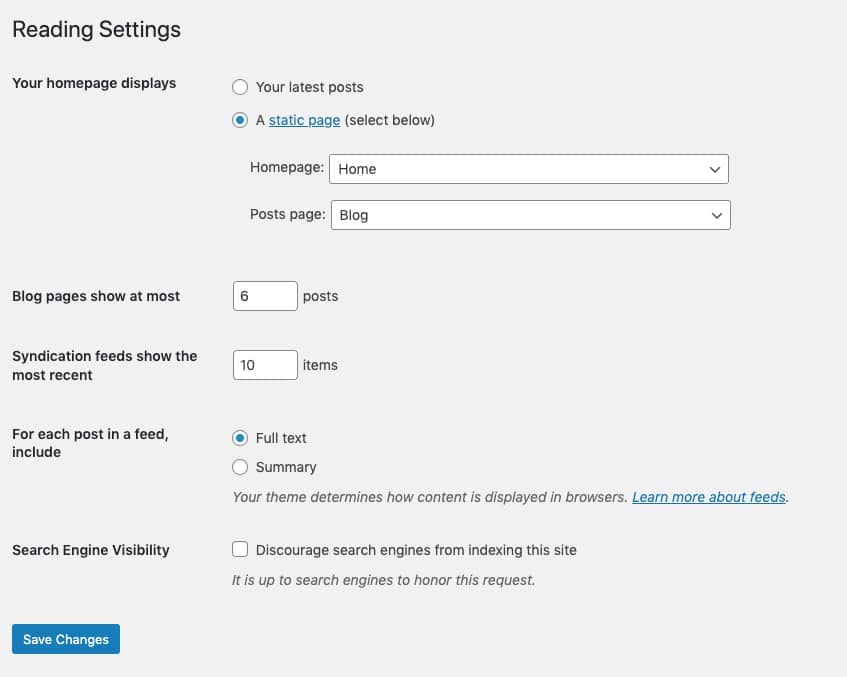The homepage can often make or break a website’s success. If it’s poorly designed, visitors probably won’t stay long, nor will search engines rank it favorably in their index.
If your website uses WordPress, though, you have multiple options for your homepage. WordPress supports both static homepages and post feed homepages.
What Is a Static Homepage?

A static homepage is a traditional homepage layout featuring content that doesn’t change or update automatically.
In WordPress, the content of a static homepage is pulled from a separate page, which is defined in the WordPress dashboardIn WordPress, the Dashboard is a central hub for managing a website's content and settings. It is the first sc... More.
You can set any page on your website as the static homepage, but you cannot set postsA post is a type of content in WordPress, a popular open-source content management system used for creating an... More to display on the static homepage. As a result, static homepages typically don’t show post-related elements like tagsIn WordPress, tags are a taxonomy used to classify and organize posts. They are similar to categories, but unl... More, categoriesIn WordPress, categories are a fundamental taxonomy used to group and organize posts based on their topics or ... More or authors. Rather, they only show the content published on the page set as the static homepage.
However, you can use a page builder pluginA plugin is a software component that adds specific features and functionality to your WordPress website. Esse... More to display more dynamic content on a static homepage.
What Is a Post Feed Homepage?

A post feed homepage, on the other hand, is a fluid homepage layout featuring some or all of a WordPress website’s posts.
By default, all WordPress websites use a post feed homepage showing the site’s 10 most recent posts in reverse-chronological order. The posts are still published on their original URL, such as example.com/first-post and example.com/second-post, but they are published on the post feed homepage as well.
With a post feed homepage, visitors will see your website’s most recent posts when landing on your homepage.
The default WordPress settings show all of the posts’ content. If you have 10 posts at 750 words each, your homepage will feature a total of 7,500 words.
With that said, you can elect to show an excerptIn WordPress, an excerpt is a summary or brief description of a post's content. It is typically used to provid... More of your site’s most recent posts rather than their entire content. Excerpts consist of the first 55 words of a post, followed by a “read more” or “continue reading” link to the original URL on which it was published.
Keep in mind, WordPress supports sticky posts for post feed homepages. If you want a post to appear at the top of your homepage, regardless of when it was published, pull up the post in the WordPress dashboard and select the option to stick the post to the top of the blog. Your homepage will now show the sticky post above all other posts.
How to Switch Between a Static and Post Feed Homepage

You can switch between a static and post feed homepage for your website by going to Settings > Reading in the WordPress dashboard. To use a post feed homepage, select the option labeled “Your latest posts” next to the homepage settings option at the top of the page.
You can also specify the number of posts that show on your post feed homepage in the field next to “Blog pagesIn WordPress, a page is a content type that is used to create non-dynamic pages on a website. Pages are typica... More show at most.” And if you want to your post feed homepage to show an excerpt of your posts, click the “Summary” button next to “For each article in a feed, show.” When you are finished configuring your post feed homepage, click the “Save Changes” button at the bottom to complete the process.
To use a static homepage, click the button labeled “A static page (select below).” You must then choose an existing page on your website to use as the static homepage. Click the drop-down menuIn WordPress, a menu is a collection of links that are displayed as a navigation menu on a website. Menus are ... More next to “Homepage” and choose your preferred page. If your website only has posts and not pages, you’ll need to publish a new page in order to use a static homepage. After choosing a page to use as the static homepage, click “Save Changes” to complete the process.
For more tips on how to do this properly, check out our tutorial on How To Edit Your Homepage In WordPress 👈
Benefits of Using a Static Homepage

Because it’s the default setting for WordPress, you may assume that a post feed homepage is the right choice for your website. After all, why would WordPress developers use this default setting if it wasn’t effective?
You can certainly build a popular and successful website using a post feed homepage, but you can generally expect better results with a static homepage.
With a static homepage, the content on your website’s homepage is more focused and coherent. Post feed homepages contain content from multiple posts, so they are somewhat distracting for visitors. When visitors see nearly a dozen posts on your website’s homepage, they may not know which one to read. For a positive user experience, use a static homepage with fixed content on a single topic.
Using a static homepage allows you to funnel visitors through your website’s conversion process. If you run an e-commerce website, you can create a static homepage featuring links to your online store’s product categories. You can even include customer reviews or testimonials on your static homepage to further drive conversions.
Another benefit of using a static homepage is higher search rankings. Google and Bing will likely rank your homepage higher if it features a static layout rather than a post feed layout. Post feed homepages contain a lot of duplicate content. Neither Google nor Bing want to show duplicate content in their index, so they may filter or demote post feed homepages.
Benefits of Using a Post Feed Homepage

While most webmasters prefer static homepages, there are still reasons to consider using a post feed homepage for your website.
If you run a news website, for example, you may only publish posts, in which case your only option is to use a post feed homepage.
Some bloggers use a post feed homepage to promote their recently published posts. If you operate a WordPress blog, using a post feed homepage allows visitors to find your blog posts more quickly, resulting in increased views and exposure.
Aside from news websites and blogs, however, most websites would benefit the most from a static homepage.
Final Thoughts
To create a strong first impression with visitors, your website needs an attractive and well-designed homepage. While WordPress supports static homepages and post feed homepages, the former layout typically works best. A static homepage promotes a more positive user experience, higher search rankings and a higher conversion rate.
If you have any questions about static homepages or post feed homepages in WordPress, please feel free to leave a comment below!



